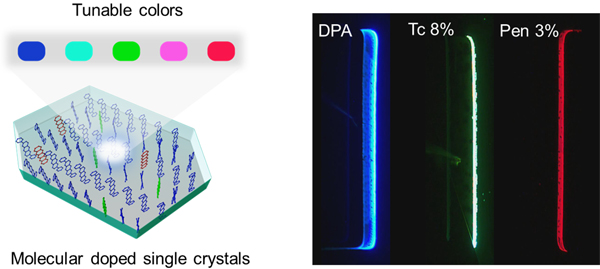Color-tunable Emissive Organic Single Crystals with High-mobility and Their Light-emitting Transistors
Organic light-emitting transistors (OLETs) combining the light-emitting function of organic light-emitting diodes (OLEDs) and the current modulation (and signal amplification) function of organic field-effect transistors (OFETs) in a single device are promising components for optoelectronics, smart display technologies, and electrically pumped lasers. To advance these technologies, it is crucial for developing high-mobility emissive organic semiconductors with tunable colors, the core active layer for OLETs, however, it remains great challenging.
In a study published in Science Advances(DOI: 10.1126/sciadv.abp8775), the research group led by Prof. DONG Huanli from the Institute of Chemistry, Chinese Academy of Sciences developed a series of color-tunable, high-mobility, emissive, organic semiconductors via a molecular doping strategy with a high-mobility organic semiconductor, 2,6-diphenylanthracene (DPA) as the host and tetracene (Tc) or pentacene (Pen) as the guest molecules.
Well-matched molecular structures and sizes, as well as efficient energy transfer between the host and guest, enable the intrinsically high charge transport properties with tunable colors. Five-colored high mobility organic semiconductors from blue-to-red including the host molecule itself are prepared with the highest mobility over 2 cm2V-1s-1 and photoluminescence quantum yield (PLQY) > 15.8%. The fluorescence spectra of molecular doped single crystals show that the degree of energy transfer increases with increasing doping concentration. The degree of energy transfer of the Pen doped samples was analyzed, and the degree of energy transfer is 53% at 0.5% doping concentration and 96% at 3% doping concentration, which is close to complete energy transfer.
Because of the high-mobility and emissive properties of the doped crystals and the asymmetric electrode device structure, the molecular doped OLETs devices exhibit strong and spatially controlled electroluminescence in both P-channel and N-channel. The excellent optoelectronic performance of the molecular doped single-crystal OLETs devices is also demonstrated by their small hysteresis and maximum photocurrent switching ratio of 5.8×102.
The color triangle achieved by DPA, Tc 8%, and Pen 3% light-emitting transistors covers 59% of the NTSC standard in the CIE 1931 color space, which greatly exceeds the 45% of the NTSC standard covered by some commercial display panels, thereby rendering their great promise for integrated full-color optoelectronic devices and circuits.
This strategy can be extended to more conjugated organic molecule systems with the rational selection of high-mobility host and guest molecules for superior performances.

The design concept of molecular doping and electroluminescence images of three primary color light-emitting transistors (Image by QIN Zhengsheng).
Contact:
Prof. Dong huanli
Institute of Chemistry, Chinese Academy of Sciences
Email: dhl522@iccas.ac.cn





